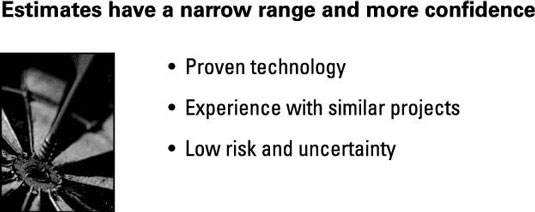Part of the estimating process on the PMP Certification Exam is looking at alternative project approaches. Sometimes, bringing in a full-time employee to fill a slot on the team is the best option; other times, going with contract labor is a better option. With equipment, you can compare cost options of purchasing, leasing, or renting. You may also look at the lifecycle cost of the product versus the project cost.
The PMBOK Guide doesn’t state definitively the degree of accuracy that you should have for cost estimates based on where you are in the project lifecycle. The PMBOK Guide and the PMP have to apply to all industries.
Several variables can affect your range of estimates and the confidence level in the estimates:
Technology
Experience
Risk
Here is an example of estimates with a higher accuracy.

There are also estimates with lower accuracy.

Expert judgment in the form of team members and estimators is invaluable. These people can select the best method of estimating, and they bring their experience in how to save money and knowing which shortcuts end up costing more in the end.
You will obviously use some type of software to record your estimates. The simplest way is to use some kind of spreadsheet. Estimating software can run simulations, develop graphs and charts, and greatly simplify the estimating and budgeting processes.
You might be accountable for different types of costs on your project:
| Direct Costs | Directly attributable to your project. Includes labor, material, travel costs, and so on. |
| Indirect Costs | Not directly attributable to your project. Includes overhead, management salaries, the legal department, and so on. |
Analogous estimating
Analogous estimating uses expert judgment and historical information to develop cost estimates. This type of estimating is used in the earlier phases of a project to get an overall project cost although it can be used at any time in the project lifecycle and at any level of detail in the WBS. You start with a similar project and identify the variables that drive the cost.
Some of the variables that are likely to drive cost are:
Size
Weight
Complexity
Parametric estimating
Parametric estimating uses a statistical relationship based on past data to calculate an estimate. For the childcare center scenario, say that the general contractor rates this type of job at about $120 per square foot, and you have 4,000 square feet. That gives you an estimate of $480,000.
Parametric estimating is easy if you have a simple model, such as cost per square foot. It can get more complex, though, with the more variables you add. To use this method, the cost-estimating relationships (CERs) need to be scalable.
Bottom-up estimating
Bottom-up estimating is the most accurate form of estimating. However, you can employ this type of estimating only toward the end of the planning process when you have detailed information about the scope. This method
Determines the cost for each resource needed to create the deliverable
Sums all deliverables
Includes the contingency reserve
Aggregates the total into a bottom-up estimate
You can’t do bottom-up estimating until you have a significant level of detail for the deliverables.
Three-point estimating
When you have a lot of uncertainty, risk, or unknowns around a work package, you can use three-point estimating to give you a range and an expected cost. You collect three estimates based on the best case, most likely, and worst case scenarios.
Best case (optimistic): Cost estimates play out while accurate, no-risk events occur, and the work takes only as long as estimated. This is represented as an o for “optimistic.” Or you might see it notated as co for “cost optimistic.”
Most likely: Takes into account the realities of project life, such as needing extra parts or people, rework, things not going exactly as planned, and so forth. This is represented as an m for “most likely.” You might see this presented as cm for “cost most likely.”
Worst case (pessimistic): Assumes expensive resources, much rework, and delays in work getting accomplished. This is represented as a p for “pessimistic” or cp for “cost pessimistic.”
The simplest way to develop the expected cost, or ce (cost expected), is to sum the three estimates and divide by three. You might see this referred to as a triangular distribution. However, that’s not the most accurate way because you assume an equal probability that the best case, most likely, and worst case scenarios would occur — and that’s not realistic.
In reality, the most likely estimate has a greater chance of occurring than either the best case or the worst case scenarios. Therefore, you weight the most likely scenario to develop a weighted average. The most common way of calculating a weighted average is
ce = (co + 4cm + cp) / 6
Notice that the numerator has six factors you are adding; therefore, the denominator to achieve the average is 6.
The PMP exam might refer to this as a Beta Distribution or PERT (Program Evaluation and Review Technique) estimating.
| Type | Benefits | Shortfalls |
|---|---|---|
| Analogous | Used if a limited amount of detailed information is
available. Useful when the estimate must be delivered within certain time constraints. |
Not as accurate as a bottom-up estimate. Can be used only when the projects are similar in fact not just in appearance. |
| Parametric | Useful if components are scalable. Useful if historical information on which the model is based is accurate. Quick. |
Parameters must be quantifiable. Not as accurate as a bottom-up estimate. Computer program needed. |
| Bottom-up | Most accurate. Buy-in from the person doing the work. Used when the project is well defined. |
Time consuming. Interaction costs may be overlooked. Contingency costs by task may inflate estimates. |
| Three-point | Used if there is a lot of uncertainty on the project. Provides a justification for cost reserve. |
Time consuming. Many people have a hard time coming up with one estimate, much less three. |

